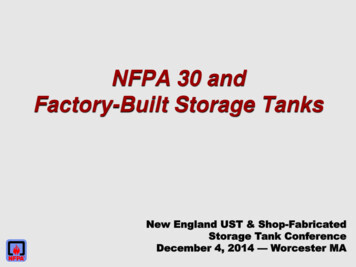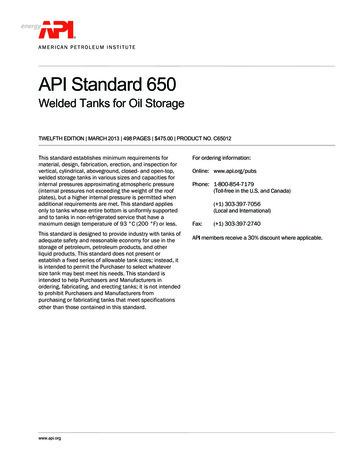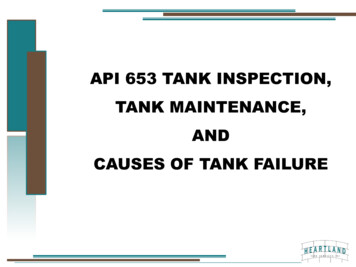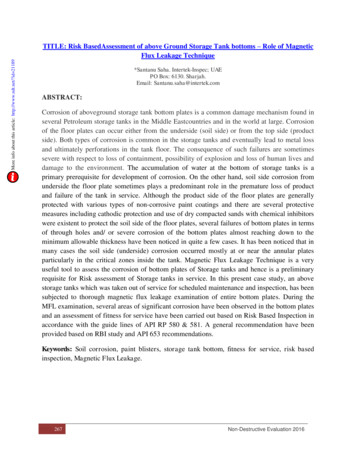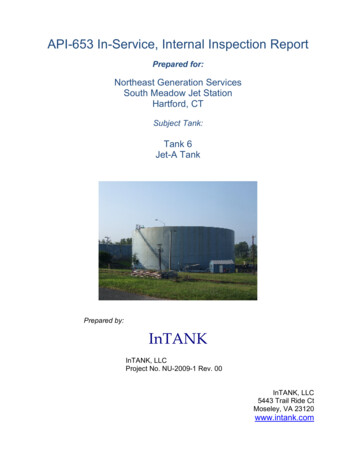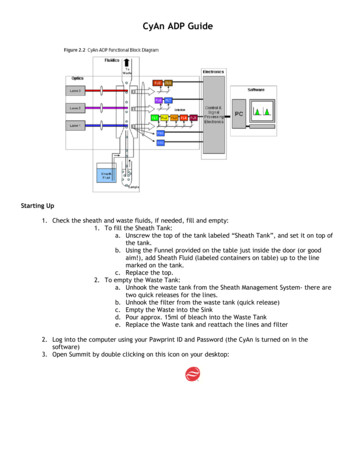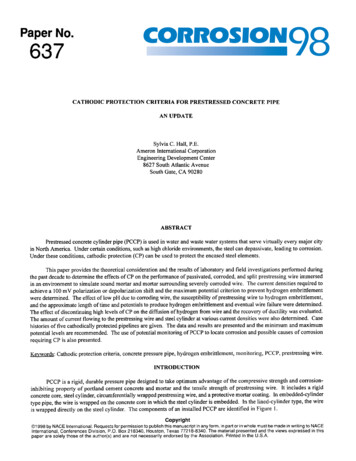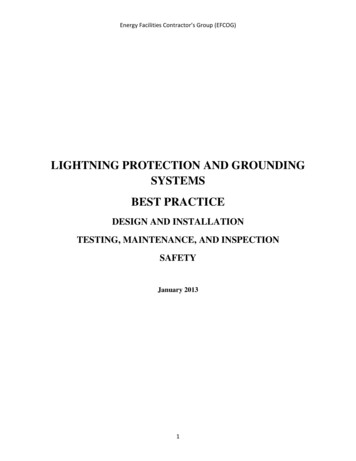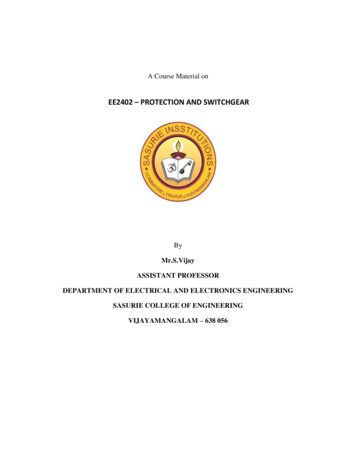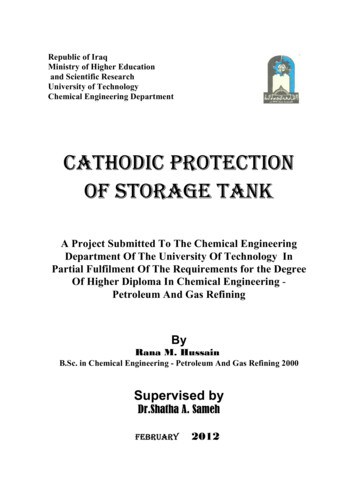
Transcription
Republic of IraqMinistry of Higher Educationand Scientific ResearchUniversity of TechnologyChemical Engineering DepartmentCathodic Protectionof Storage TankA Project Submitted To The Chemical EngineeringDepartment Of The University Of Technology InPartial Fulfilment Of The Requirements for the DegreeOf Higher Diploma In Chemical Engineering Petroleum And Gas RefiningByRana M. HussainB.Sc. in Chemical Engineering - Petroleum And Gas Refining 2000Supervised byDr.Shatha A. SamehFebruary2012
SUPERVISOR CERTIFICATIONI certify that this project entitled “ Cathodic Protection OfStorage Tank ” was prepared under my supervision as a partialfulfilment of the requirements for the degree of Higher DiplomaScience in Chemical Engineering at the Chemical EngineeringDepartment , University of Technology.Signature :Dr. Shatha A. SamehAssistant ProfessorSupervisorData:/ /2012In view of the available recommendations, I forward this researchfor debate by the Examination Committee.Signature:Dr. Mohamed I. MohamedAssistant ProfessorHead of Post Graduate CommitteeDepartment of Chemical EngineeringData://2012
EXAMINATION COMMITTEE CERTIFICATEWe certify that we have read this project entitled “ CathodicProtection Of Storage Tank ”and as examining committeeexamined the student Rana M. Hussain in its contents and that inour opinion it meets the standards of a project for the degree ofHigher Diploma in Chemical Engineering Petroleum and GasRefining .Signature :Dr. Shatha A. SamehSupervisorData:/ /2012Signature:Signature:Dr. Jamal M. AliDr. Issam K. SalihMemberDate:/Chairman/ 2012Date:// 2012Signature:Prof. Dr. Momtaz A. ZablukHead of the Chemical Engineering DepartmentDate:// 2012
AbstractCathodic protection is an electrochemical means of corrosionprevention technique which uses the electrochemical properties of metals toinsure that the structure to be protected becomes the cathode of anelectrolytic cell.The purpose of present work is to construct cathodic protection (CP)system to prevent structures from corrosion . A case study for protecting18.000 m3 crude oil storage tank exists in DURA refinery was investigated.The scope of work included the design and determination of all necessarymaterials for the internal cathodic protection of tank bottom and one meterheight of tank wall. utilizing Aluminum anodes as sacrificial anodes .The results showed that the cathodic protection required 230 anoderods (N), Current output (one anode) 0.138 Amp , Minimum distancebetween anodes “ Lmin” 2.607 m , Protecting diameter for one anode“Danode ” 1.471 m .I
List of TablesCHAPTER TWOTypical current density required for cathodic protection of uncoatedsteel(3-1)PH value and corrosion(3-2)Galvanic anode characterization(3-3)Impressed Current Anodic Material and their PropertiesVI(3-4)
List of ContentsAbstractIAbbreviationIINomenclatureIIIList of FigureVList of TableVICHAPTER ONE / INTRODUCTION1.1Introduction-11.2 The aim of present work2CHAPTER TWO / THE PRINCIPLES OF CORROSION AND CATHODIC PROTECTION2.1Introduction32.2Corrosion principles &mechanisms42.2.1 Understanding Corrosion42.2.2 Corrosion Cell52.2.3 Cathodic & Anodic reactions62.3 Common forms of corrosion72.4 Corrosion damage82.5 Corrosion Prevention9II
List of Contents2.5.1 Materials Selection92.5.2 Design Consideration92.5.3 Corrosion Inhibition102.5.4 Coating Control Corrosion102.5.5 Cathodic Protection102.6 Cathodic Protection & its relation to the electrochemical theoryof corrosion112.6.1 Current density requirement132.7 Sacrificial anode system152.7.1 Introduction152.7.2 Galvanic anode types162.7.3 Advantages and Disadvantages182.7.3.1 Advantages182.7.3.2 Disadvantages182.8 Impressed Current182.8.1 Introduction182.8.2 Anodes202.8.3 Advantages and Disadvantages222.8.3.1 Advantages222.8.3.2 Disadvantages222.9 Cathodic protection system Selection232.10 Application23III
List of ContentsCHAPTER THREE/ CASE STUDY3.1 Oil Storage Tank253.2 Requirements of the internal surface of Oil Storage Tank273.2.1 Design Condition273.2.2 Calculation28ReferencesIV
List of FiguresCHAPTER TWOCorrosion cell(2-1)Current density system is explained(2-2)Sacrificial Anode System( 2-3)Impressed Current System( 2-4)CHAPTER THREELayout of storage tank(3-1)Anode installation(3-2)Anode layout plan for Aluminum(3-3)V
NomenclatureSymbolMeaningUnitDDiameter of tankmhWater levelmρResistivityΩ.cmlDesign current densitymAp/m2wWeight (for one anode)kgICurrent capacity of anodekg/Amp. yearΔEPotential difference for anode in sea watermVStTank bottom surface area to be protectm2SrTank shell area to be protectm2StotalTotal surface area to be protectm2TtotalTotal current required at design current densityAmpwTotal weight of anode rodskgNRequired number of anodeea.SanodeProtected area by one anodem2L minMinimum distance between anodesmD anodeProtecting diameter by one anodemIII
NomenclatureEcorrCorrosion PotentialvolticorrCorrosion current densityμA/cm2IV
chapter 1INTRODUCTIONCHAPTER ONEINTRODUCTION1.1 IntroductionCorrosion is defined as the chemical or electrochemical reactionbetween a material, usually a metal or alloy, and its environment thatproduces a deterioration of the material and its properties. According to thecharacteristics of the environment, corrosion processes are classified aschemical or electrochemical . Corrosion is a costly worldwide problem. Inaddition to the huge cost in economic terms, corrosion is also blamed formany of the disasters that cause loss of life and devastating pollution to theenvironment. [1]Five different main principles can be used to prevent corrosion:appropriate materials selection, change of environment, suitable designapplication of coatings ,electrochemical i.e. cathodic and anodic protection,.The choice between these possibilities is usually based upon economicconsiderations, but in many cases aspects such as appearance, environmentand safety must also be taken care of. Two or more of the five principles arecommonly used at the same time. [2]Corrosion occurs on all metallic structures that are not adequatelyprotected. The cost of replacing a structure which may have been destroyedor weakened due to excessive corrosion is substantial but avoidable, andmeans should be taken to consistently prevent or mitigate this added costthrough cathodic protection [3]1
chapter 1INTRODUCTIONCathodic protection (CP) is a technique to control the corrosion of a metalsurface by making it the cathode of an electrochemical cell. The simplestmethod to apply CP is by connecting the metal to be protected with anothermore easily corroded metal to act as the anode of the electrochemical cell.Cathodic protection systems are most commonly used to protect steel of wateror fuel pipelines , storage tanks, steel pier piles, water-based vessels includingyachts and powerboats, offshore oil platforms and onshore oil well casings.Today, galvanic or sacrificial anodes are made in various shapes using alloys ofzinc, magnesium and aluminium. The electrochemical potential, currentcapacity, and consumption rate of these alloys are superior for CP than iron. [4]1.2 The aim of present workThe purpose of present work is to construct cathodic protection (CP)system to prevent structures from corrosion by utilizing Aluminum anodes assacrificial anodes.2
Chapter 2THE PRINCIPLES OF CORROSION AND CATHODIC PROTECCTIONOCHAPTER TWOTHE PRINCIPLES OF CORROSION AND CATHODICPROTECTION2.1 IntroductionCorrosion refers to the deterioration of a material due to reactions with itsenvironment .[5]In nature, most metals are found in a chemically combined state knownas ore. Ores may be oxides, Sulphides, Cabronates or other complexcompounds. In order to separate a metal such as iron from one of its ores, e.g.iron oxide, it is necessary to supply a large amount of energy. Therefore, metalsin their un combined condition are usually high-energy states. It is this tendencyof metals to recombine with components of environment that the phenomenonknown as corrosion. Deterioration by physical causes is not called corrosion,but is described as erosion, galling, or wear. In some instances, chemical attackaccompanies physical determination as described by the term: corrosionerosion, corrosion wear or fretting corrosion .[6]Cathodic protection (CP) is a technique to control the corrosion of ametal surface by making it the cathode of an electrochemical cell. Thesimplest method to apply CP is by connecting the metal to be protected withanother more easily corroded metal to act as the anode of the electrochemicalcell. [7]Cathodic protection (CP) has been known for about 170 years. Primarilyit has been used for protection of ordinary structural steel in soil andseawater, more seldom (and under special conditions) for steel exposed to3
Chapter 2THE PRINCIPLES OF CORROSION AND CATHODIC PROTECCTIONOfresh water. Other materials can also be protected by CP, for instance toprevent localized corrosion on stainless steel and aluminium. In recentdecades the application of this technology has increased considerably inconnection with the expanding offshore oil and gas exploration andproduction. [8]Cathodic protection was therefore neglected for 100 years after which itbegan to be used successfully by oil companies in the United States to protectunderground pipelines. It is interesting that the first large-scale application ofcathodic protection by Davy was directed at protecting copper rather thansteel. [9]2.2 Corrosion principles &mechanisms2.2.1 Understanding CorrosionCorrosion of metallic materials can be divided into three main groups; Wet corrosion, where the corrosive environment is water with dissolvedspecies. The liquid is an electrolyte and the process is typicallyelectrochemical. Corrosion in other fluids such as fused salts and molten metals. Dry corrosion, where the corrosive environment is a dry gas. [10]4
Chapter 2THE PRINCIPLES OF CORROSION AND CATHODIC PROTECCTIONO2.2.2 Corrosion CellFrom the process of corrosion it should be apparent that there are fourfundamental components in an electrochemical corrosion cell. An anode. A cathode. A conducting environment for ions (electrolyte). An electrical connection between the anode and cathode for the flow ofcurrent.If any of the above components is missing or disabled, theelectrochemical corrosion process will be stopped. Clearly, these elementsare thus, fundamentally important for corrosion control.[11]corrosion mitigation techniques are based on the principles of corrosion cellas shown in Fig. (2.1) .[ 12]Fig. (2.1) Corrosion cell [ 12]5
Chapter 2THE PRINCIPLES OF CORROSION AND CATHODIC PROTECCTIONO2.2.3 Cathodic & Anodic reactionsCorrosion of most common engineering materials at near-ambienttemperatures occurs in aqueous (water-containing) environments and iselectrochmical in nature. The aqueous environment is also referred to as theelectrolyte and, in the case of underground corrosion, is moist soil. Thecorrosion process involves the removal of electrons (oxidation) of the metal[Equation (1)] and the consumption of those electrons by some otherreduction reaction, such as oxygen or water reduction [Equations (2) and (3),respectively]:FeFe 2e O₂ 2H₂O 4e 2H₂O 2e (1)4OH (2)H₂ 2OH (3)The oxidation reaction is commonly called the anodic reaction and thereduction reaction is called the cathodic reaction. Both electrochemicalreactions are necessary for corrosion to occur.The oxidation reaction causes the actual metal loss but the reductionreaction must be present to consume the electrons liberated by the oxidationreaction, maintaining charge neutrality. Otherwise, a large negative chargewould rapidly develop between the metal and the electrolyte and thecorrosion process would cease.[13]6
Chapter 2THE PRINCIPLES OF CORROSION AND CATHODIC PROTECCTIONO2.3 Common forms of corrosionIt is suggested that a corrosion case should be described at least by itsform, the corrosion reactions and corrosion products. A type of corrosion isexpected to characterize, and describe more profoundly the circumstancesleading to a corrosion or a failure of a certain material and complement themore vast divisions of the six forms of corrosion Modes of Corrosion.Fontana defined eight forms of corrosion, as general corrosion, pittingcorrosion, inter granular corrosion, parting, galvanic corrosion, crevicecorrosion, stress–corrosion cracking and erosion–corrosion. In refining theseeight forms, there are really two broad categories of modes of corrosion:Intrinsic and extrinsic. The intrinsic modes of corrosion which occurindependent of design are: [14] General corrosion Pitting Intergranular corrosion Parting Stress–corrosion crackingThe extrinsic modes affected by the design include: Crevice or under-deposit corrosion Galvanic corrosion Erosion–corrosion Fretting corrosion Corrosion fatigue7
Chapter 2THE PRINCIPLES OF CORROSION AND CATHODIC PROTECCTIONO2.4 Corrosion damageBroader application of corrosion-resistant materials and the applicationof the best corrosion-related technical practices could reduce approximatelyone-third of these costs. Advances have been made in the use of stainlesssteels, coated metals, and more protective finishes. Moreover, severalsubstitutions of materials made primarily for reasons of weight reductionhave also reduced corrosion. The industry is estimated to have eliminatedsome 35 percent of its “avoidable” corrosion by its improved practices.[15]Corrosion mitigation becomes important which adds to the costs of theplant operation. The other alternative is to choose corrosion-resistantmaterials, which may be expensive, resulting in high initial costs. It is alsopossible to use coatings or cathodic protection, resulting in additional costs.The economic considerations and factors such as plant life dictate the choiceof materials and the corrosion prevention strategies used.[16]2.5 Corrosion PreventionAlthough enhancing the materials selection process to pay closerattention to corrosion prevention and control may cost more initially, thereare many potential benefits that will result including improved reliability,reduced maintenance, increased availability, improved performance andefficiency, improved safety, increased service life, and reduced life-cycle cost8
Chapter 2THE PRINCIPLES OF CORROSION AND CATHODIC PROTECCTIONOIn addition, extending the life of a fielded system is far easier and lesscostly if excessive corrosion is prevented from occurring in the firstplace.[17]2.5.1 Material Selection:The right choice of material in relation to corrosive medium .[18]Then material must be selected to the design stage with consideration given tocorrosion resistance, mechanical strength, workability, and cost. For example,carbon steel is the almost exclusive choice of pipelines designers. [19]2.5.2 Design Considerations:The use of acceptable engineering practices to minimize corrosion isfundamental to corrosion control. This is accomplished by engineering design .In design the structure care must be taken to avoid such as crevices, contactbetween different metals, welding practice and easy installation of cathodicprotection .[20]2.5.3 Corrosion InhibitionInhibitors are chemicals that act to slow down corrosion they are thepreferred methods of corrosion control in closed and recalculating cooling andheating system using water as the heat transfer medium and are the only costeffective method for corrosion control of steel pipelines in the oil and gasindustry. [21]9
Chapter 2THE PRINCIPLES OF CORROSION AND CATHODIC PROTECCTIONO2.5.4 Coating Control CorrosionCoating control corrosion placing a barrier between the pipe and thesurrounding environment, eliminating the electrolyte. The effectiveness isdependant upon the integrity of the coating. i.e. how many holes are present,strength of bond with the metal, and ability to insulate the pipe from electricalcurrent. Example of common coating as asphalt, concrete, epoxies, polyvinylchloride (PVC), and poly ethylene.[22]2.5.5 Cathodic ProtectionCathodic protection is a common and successful form of corrosioncontrol in a variety of situations, for example, submerged marine structures,pipelines, chemical plant, oil storage and rebars corrosion in concrete.Current research is focusing on a number of areas including aluminumanodic, magnesium anodic, potential mapping, influences of defects on coatedsteel, monitoring of cathodic protection system and protection of oil field water.[22]10
Chapter 2THE PRINCIPLES OF CORROSION AND CATHODIC PROTECCTIONO2.6 Cathodic protection & its relation to the electrochemical theory ofcorrosionCathodic protection is a method to reduce corrosion by minimizing thedifference in potential between anode and cathode. This is achieved by applyinga current to the structure to be protected (such as a pipeline) from some outsidesource. When enough current is applied, the whole structure will be at onepotential; thus, anode and cathode sites will not exist. Cathodic protection iscommonly used on many types of structures, such as pipelines, undergroundstorage tanks, locks, and ship hulls.[23]Cathodic protection is an electrochemical method allowing control of ingonthemetal/electrolyte phase boundary by DC current polarisation.The generally accepted principles of this initially empirical method can beexplained by kinetics of electrode processes, the foundations of which are givenby the Wagner and Traud mixed potential theory. The principle of cathodicprotection in a potential . current density system is explained in Fig (2.2) .11
Chapter 2THE PRINCIPLES OF CORROSION AND CATHODIC PROTECCTIONOFig (2.2) Current density system [25]It presents the relation of anodic and cathodic reaction partial currentsaccompanying the steel corrosion process, i.e., their rate from the imposedpotential. In zero current conditions an equilibrium state is established on thesurface of steel, in which the anodic (oxidation) process rate is equal to thecathodic (reduction) process rate. This state is characterised by corrosionpotential Ecorr and corrosion current density icorr.By cathodically polarising the pipeline with a DC current, henceappropriately changing the potential from the corrosion potential in thenegative direction, one may slow down or hinder the anodic reaction of ironionisation responsible for the corrosion process.12
Chapter 2THE PRINCIPLES OF CORROSION AND CATHODIC PROTECCTIONOPartial cathodic protection is ensured, for example, by polarisation ofsteel to potential E. with a current i., at which the corrosion current decreasesto value icorr. Full hindering of the corrosion process requires polarisation ofthe metal to the reversible potential of the anodic reaction Eo.[24]2.6.1 Current density requirementThe current required for cathodic protection depends upon the metalbeing protected and the environment. The potentials required to determineadequate protection (criteria). To achieve these protective potentials, currentmust flow from the anode to the structure being protected.The amount of current required to protect a given structure isproportional to the area of the structure that is exposed to the electrolyte.Therefore, current requirements are usually given as current densities in unitsof amperes or milliamperes (0.001 amperes) per square meter (foot) ofexposed surface.[25]The pH of environment will also be important, the presence of coating,marine fouling, and calcareous deposits will have a profound effect oncurrent density, for economic and technical reasons a low current is desirableSome typical current requirement in a range of different environment is givenin Table (2-1) and PH value and corrosion in table (2-2).[26]13
Chapter 2THE PRINCIPLES OF CORROSION AND CATHODIC PROTECCTIONOTable (2-1)Typical current density required for cathodic protection of uncoated steel[27]Table (2-2) PH value and corrosion [27]14
Chapter 2THE PRINCIPLES OF CORROSION AND CATHODIC PROTECCTIONO2.7 Sacrificial anode system2.7.1 IntroductionA galvanic cathodic protection system makes use of the corrosivepotential for different metals, one area of the structure exists, at more negativepotential than another, and corrosion results if, however, a much less inertobject (that is, with much more negative potential, such as magnesium anode isplaced adjacent to the structure to be protected such as pipelines; and metallicconnection (insulated wire) is installed between the object and the structure, theobject will become the anode and the entire structure will become the cathode.That is, the new object corrodes sacrificially to protect the structure . Thus, thegalvanic cathodic protection system is called "a sacrificial anode cathodicprotection system "because the anode corrodes sacrificially to protect thestructure [28], a shown in fig. (2-3 )Fig. (2-3 ) A sacrificial anode cathodic protection system [28]15
Chapter 2THE PRINCIPLES OF CORROSION AND CATHODIC PROTECCTIONOCathodic protection in the sacrificial anode system is essentially acontrolled electrochemical cell. Corrosion on the protected structure is shiftedto the anode. The anode is consumed in the process but is designed andinstalled so that it is easily replaced when consumed. Anode life of 10 to 15years is common. Anode life is dependent upon the amount of current emittedby the anodes and their size. [29]2.7.2 Galvanic anode typesGalvanic anode protection is often called "sacrificial" because the anodeis thought of as "sacrificing" itself to protect the structure. This type ofprotection utilizes a galvanic cell consisting of an anode made from a moreactive metal than the structure. The anode is attached to the structure, eitherdirectly or, to permit measurement of the anode output current, through a teststation . [30]The following three metals are the most common galvanic anodematerials and the galvanic anode characterisation in table(2.3) Magnesium Zinc Aluminum16
Chapter 2THE PRINCIPLES OF CORROSION AND CATHODIC PROTECCTIONOTable (2.3) Galvanic anode -h/kgA-h/kgType I860781Type II816739MaterialconsumptionEff %RatePotentialKg/A-yearto -8.61.70-1.80ZincMagnesiumH-1 l/ Zn/ Hg29772822953.11.06Al/ Zn/ In29772591873.31.11(a) Cu/ CuSO4 reference electrode17
Chapter 2THE PRINCIPLES OF CORROSION AND CATHODIC PROTECCTIONO2.7.3 Advantages and Disadvantages2.7.3.1Advantages[32] Simple to install. Independent of any source of electric power (self-powered). Low maintenance requirement. Less likely to cause stray current interference problem on neighboringstructures. When the current requirement is small, a galvanic system is moreeconomical than impressed current system.2.7.3.2 Disadvantages [32] Low driving voltage. Limited to use in low resistivity soils. Not an economical source of large amounts of cathodic protectioncurrent.2.8 Impressed Current 2.8.1 IntroductionImpressed current systems are sometimes called rectifier systemsbecause they utilize a device (a rectifier) to convert an external AC powersource to the required DC power source. In this type of system, anodes are18
Chapter 2THE PRINCIPLES OF CORROSION AND CATHODIC PROTECCTIONOinstalled in the soil around the structure to be protected and the DCpower is supplied to the anodes through buried wires. [33]The main difference between galvanic and impressed current systems isthat the galvanic system relies on the difference in potential between the anodeand structure; whereas the impressed current system uses an external powersource to drive the currents shown in fig.( 2-4 ).[34 ]Fig. (2-4) Impressed current system [34 ]The external power source is usually rectifier, that converts ordinary ACpower to DC, current is carried in the external circuitry as electrons, freeelectrons do not exist in an electrolyte solution; therefore, the current must becarried by positively and negatively charged ions.The current through theelectrolyte solution, equal to that in the external circuit.19
Chapter 2THE PRINCIPLES OF CORROSION AND CATHODIC PROTECCTIONOPositively charged ions carrying the current electrochemical reactions atthe electrodes are responsible for the mechanism of cathodic protection and forthe transfer of charges from electron to ions at the electrode surface. Impressedcurrent means that a current is impressed between the buried structure and ananode, this force averesal of the current, and causes the anode to be consumedrather than the pipe. [35]2.8.2 AnodesImpressed current system anodes include materials such asgraphite, silicon iron, Platonized precious metal and lead alloy shown inTable (2-4).[36]Table (2-4)Impressed Current Anodic Material and their Properties [36]ConsumptionMaterialKgAyPlatonized,titanium andMarine environment poTable water,8 * 10-6titaniumHigh silicon ironcarbonaceous backfill and high purityliquids.niobiumPlatonizedRecommended uses-18 * 10-60.2 – 1.0Marine environment poTable water.PoTablewaterandcarbonaceous backfill.20soilor
Chapter 2SteelTHE PRINCIPLES OF CORROSION AND CATHODIC PROTECCTIONO6.8 – 9.1IronApprox 9.5Cast iron4.5 – s.0.09Marine environment.Lead- silver0.09Marine environment.0.1 – 1.0backfillcarbonaceous.Lead- platinumGraphiteandMarine environment, potable water,and carbonaceous backfill.The anodes are usually distributed at regular intervals over the whole ofstructure, rather than in small numbers which must protect large area, there aretwo main reasons for this.A large current density in the immediate vicinity of ananode is damaging to many types of paint film. The use of more anodes reducesthe current output of each anode and lessens the damage to the protectivecoating.In the complex geometrical arrangement off shore, it is difficult topredict the distribution of potential consequently; it is safer to employ moreanodes to protect smaller area. If any doubt exists about the ability of an anodeto protect a particular part of the structure.Graphite anode is one of the mostcommonly used for impressed current system, graphite anode was chosen for ofthe following reason. [37]21
Chapter 2THE PRINCIPLES OF CORROSION AND CATHODIC PROTECCTIONO2.8.3 Advantages and Disadvantages2.8.3.1 AdvantagesAn impressed current system is used to protect large bare and coated structureand structures in high resistively electrolytes and have the followingadvantages. [38] The large driving force available can protect a large, even uncoatedstructure in high resistively environments. Few anodes are used comparatively with sacrificial anode systems.2.8.3.2Disadvantages Increased maintenance. May cause interface on other structures. High operating costs.2.9 Cathodic Protection System SelectionWhen selecting which type of system to use, the designer should considerthe size of the structure to be protected and past project experience in operatingand maintaining both types of systems. Early in the selection process, ifpractical, it is useful to perform a current requirement test to help define thetotal amount of electrical current needed to protect the structure.22
Chapter 2THE PRINCIPLES OF CORROSION AND CATHODIC PROTECCTIONOFor large structures with significant expanses of bare or poorly coatedmetal, where the total current requirement tends to be very high, a properlymaintained impressed current system can provide 10 to 30 years of effectivecorrosion protection. Where current requirements are lower and the structure’sprotective coatings are well maintained, sacrificial anode systems can be veryeffective. Improved modern coating systems and maintenance practices todayallow for a wider use of sacrificial CPSs on large civil works structures thanwas the case in the past. For both types of systems, preliminary designestimations and comparisons of costs, current output, and overall design lifeshould give an adequate indication of which system is preferable for the specificapplication. Other factors such as future maintenance needs, reliability,accessibility, and impact on operations may also warrant consideration.[39]2.10 ApplicationThe connections are similar for the application of cathodic protection tometallic storage tanks, jetties, offshore structures and reinforced concretestructures.[40]Specifying the use of cathodic protection initially will avoid the need toprovide a “corrosion allowance” to thin sections of structures that may be costlyto fabricate. It may be used to afford security where even a small leak cannot betolerated for reasons of safety or environment. Cathodic protection can, inprinciple, be applied to any metallic structure in contact with a bulk electrolyte(including concrete). In practice, its main use is to protect steel structures buriedin soil or immersed in water. It cannot be used to prevent atmospheric corrosion23
Chapter 2THE PRINCIPLES OF CORROSION AND CATHODIC PROTECCTIONOon metals. However, it can be used to protect atmospherically exposed andburied reinforced concrete from corrosion, as the concrete itself containssufficient moisture to act as the electrolyte. Structures that are commonlyprotected by cathodic protection are the exterior surfaces of: Pipelines Ships’ hulls Storage tank bases Jetties and harbour structures Steel sheet, tubular and foundation pilings Offshore platforms, floating and sub sea structuresCathodic protection is also used to protect the internal surfaces of: Large diameter pipelines Ship’s tanks (product and ballast) Storage tanks (oil and water) Water-circulating systems.[41]24
Chapter 2THE PRINCIPLES OF CORROSION AND CATHODIC PROTECCTIONO25
chapter 3CASE STUDYCHAPTER THREECASE STUDY3.1 Oil Storage TankThe low carbon steel was us
18.000 m3 crude oil storage tank exists in DURA refinery was investigated.The scope of work included the design and determination of all necessary materials for the internal cathodic protection of tank bottom and one meter height of tan
